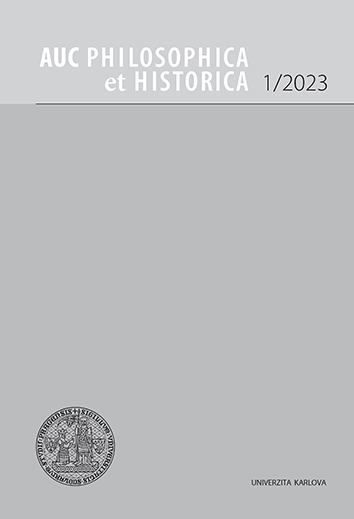AUC Philosophica et Historica (Acta Universitatis Carolinae Philosophica et Historica) is a multidisciplinary academic journal focused on the humanities with more than 50 years of tradition.
The journal is indexed in CEEOL, DOAJ, and EBSCO.
AUC PHILOSOPHICA ET HISTORICA, Vol 2021 No 2 (2021), 89–99
„Býti národním v umění je směšný pleonasmus. Národní je i spánek.“ K německočeské debatě nad moderním meziválečným uměním
[“To Be National in Art Is a Ridiculous Pleonasm. Sleep Is Also National.” On the German-Czech Debate on Modern Art]
Ivo Habán
DOI: https://doi.org/10.14712/24647055.2024.12
published online: 01. 10. 2024
abstract
As an art historian who has long focused on the manifestations of the visual culture of the German-speaking scene in the Czech lands, I have repeatedly encountered the topic of perceiving the “Czechness” and “worldliness” of domestic production. From my research perspective, I see two levels in this beautiful and provocative challenge. The first is the evergreen of German-Bohemian art, i.e. if we apply a national or geographical scale to the artistic expressions that emerged from the Czech lands. Today, of course, we take a geographical view, but if we look at the production of individual regions side by side, it is impossible not to see clear differences on the part of the ethnically Czech and German scenes. Capturing and defining more universally some of the subliminal specifics that are apparent at first glance is a challenge that still occupies me mentally, despite the awareness of the absurdity of searching for a national definition of art. Fixing the key features is complicated by the existence of multicultural exceptions, which often introduce an element of Judaism into the traditional dualism of the period under review. These exceptions successfully disrupt the flattened idea of parallel Czech- and German-speaking cultural and social worlds of the Czech lands. Moreover, it is precisely these exceptions that are often the bearers of tendencies towards imaginary worldliness, which brings us to the second level of this consideration – to what extent and through what phenomena the territorially and numerically relatively small art scene of the Czech lands can be perceived as world-class. The answer may be the market, or a confident search for regional authenticity. In the words of Josef Kroutvor, “minor branches of modernity.” It seems to me that in today’s global world, their offsprings are more important than many textbook examples of the avant-garde.
keywords: German-Czech art; national art; nationalism in art; minor branches of modernity; regionalism
references (6)
1. Bartlová Milena, Naše, národní umění: studie z dějin dějepisu umění, Brno 2009.
2. Bartlová Milena a kol., Budování státu: reprezentace Československa v umění, architektuře a designu, Praha 2015.
3. Habán Ivo (ed.), Nové realismy: moderní realistické přístupy na československé výtvarné scéně 1918-1945, Liberec 2019.
4. Habánová Anna (ed.), Mladí lvi v kleci: umělecké skupiny německy hovořících výtvarníků z Čech, Moravy a Slezska v meziválečném období, Řevnice - Liberec 2013.
5. Pachmanová Martina (ed.), Z Prahy až do Buenos Aires: "ženské umění" a mezinárodní reprezentace meziválečného Československa, Praha 2014.
6. Vybíral Jindřich, Co je českého na umění v Čechách? Vybrané texty z let 2004-2021, Praha 2022.

„Býti národním v umění je směšný pleonasmus. Národní je i spánek.“ K německočeské debatě nad moderním meziválečným uměním is licensed under a Creative Commons Attribution 4.0 International License.
